#Glottertal
Explore tagged Tumblr posts
Text

The Largest Medieval Coin Hoard Found in Decades Discovered in Germany
Archaeologists have unearthed one of the largest medieval coin hoards, consisting of approximately 1,600 coins, in recent years in the village of Glottertal in the Breisgau-Hochschwarzwald region of Germany.
This remarkable discovery provides a unique window into the economic activities of Europe in the fourteenth century and illuminates the minting industry, silver trade, and wider circulation of money in Breisgau.
According to a press statement issued by the State Office for Monument Preservation in the Stuttgart Regional Council, the hoard was unearthed during construction works while excavating a trench.

The treasure was discovered by Claus Völker, a local citizen who was assisting with the laying of a pipeline near the village swimming pool in early May 2024, records a press release.
Völker caught sight of what he initially described as “small metal plates” within the excavation. He reported the discovery to the Stuttgart Regional Council’s State Office for Monument Preservation (LAD) as soon as he realized the objects’ possible significance. The same day, Völker and LAD archaeologists visited the site the same day to recover the coins and discovered a whopping 1000 coins.
At the same time, three detectors certified by the LAD were assigned to search for the loot. The interior of the trench became a knee-deep quagmire due to bad weather, but the determined researchers managed to find an additional 600 coins in the small window that was open to them.

Initial examination and cleaning of the coins indicated where they came from. The bulk of the coins, according to LAD archaeologist Andreas Haasis-Berner, were struck circa 1320 and originated from a number of well-known mints, including Breisach, Zofingen, and Freiburg. There were also coins from Colmar, Laufenburg, Zurich, Basel, and St. Gallen.
Commenting on the significance of the find, Haasis-Berner explained: ‘Analysing this coin hoard will provide information about the circulation of coins in Breisgau, the minting activity in the mints, the silver trade and also mining in the Glottertal valley.’ When asked whether the treasure was very valuable at the time, the archaeologist said: ‘You could have bought around 150 sheep with the coins.’

This wide variety of coins bears witness to the wide-ranging commerce networks and currency exchange that existed in the area in the early 14th century. Because of the wealth and power of the cities that produced them, every coin tells a tale about the political and economic environments of medieval Europe.
Officials described the artifacts as one of the largest coin treasures found in recent decades. Of course, this description is a small number compared to the more than 100,000,000 coins in Japan on 4 November 2023, some of which are more than 2000 thousand years old.
By Oguz Kayra.

#The Largest Medieval Coin Hoard Found in Decades Discovered in Germany#village of Glottertal#silver#silver coins#collectable coins#treasure#metal detector#metal detecting finds#ancient artifacts#archeology#archeolgst#history#history news#ancient history#ancient culture#ancient civilizations#medieval#medieval europe#middle ages
25 notes
·
View notes
Text
Scoperta in Germania, dal fango riemerge un tesoro di oltre 1.000 monete medievali: "È il più importante degli ultimi decenni"
Archeologia | Scoperta in Germania, dal fango riemerge un tesoro di oltre 1.000 monete medievali: "È il più importante degli ultimi decenni"
Elena Percivaldi Oltre un migliaio di monete medievali sono state scoperte in Germania, in quello che è stato definito dagli archeologi “uno dei più estesi ritrovamenti numismatici degli ultimi decenni”. Artefice del rinvenimento è un tale di nome Claus Völker, un semplice cittadino di Glottertal, nel Baden-Württemberg. Nel maggio scorso mentre erano in corso alcuni lavori nei pressi della…
#argento#Baden-Württemberg#commercio#economia#Germania#Landesamt für Denkmalpflege im Regierungspräsidium#Medioevo#monete#numismatica#Ufficio statale per la conservazione dei monumenti (LAD)#zecche
0 notes
Video
DSC04039.jpg von Rainer Über Flickr: Im Glottertal
0 notes
Text
Ausflugtipp: Zweribachwasserfälle, 20km östlich von Freiburg

Mal was neues, was wo wir noch nie waren: Die Zweribachwasserfälle!
Der Frühling war da, der Sommer kommt so langsam aber sicher in Fahrt. Meiner Frau gingen die ewig gleichen Ausflugsziele mal wieder auf die Nerven. Nicht schon wieder auf den Schauinsland wandern, da waren wir doch erst. Nicht schon wieder in den Herdemer Wald. Nicht nach Colmar, sie will Natur. Aber länger als eine halbe Stunde Autofahrt war auch unerwünscht. Wohin also in der Gegend mit der Bedingung noch nie dagewesen zu sein? Google Maps ist da eine große Hilfe. Ein wenig rum gescrollt, zwischen Satelliten und Karten Ansicht wechseln und siehe da, was ist denn das? Die Zweribachwasserfälle. Bis Dato kannte ich nur die Todtnauer und Triberger Wasserfälle. Also kleine Wanderroute überlegt und los ging es. Eines vorab: Kinderwagen geeignet ist der Weg nicht!
Wo liegen die Zweribachwasserfälle genau?
Die Zweribachwasserfälle erreich man von Freiburg aus auf zwei Wegen. Entweder über St. Peter, also östlich Richtung Höllental fahren und dann höhe Kirchzarten nach St. Peter fahren, oder aber über das Glottertal, also Freiburg Nord Richtung Denzlingen ins Glottertal rein. Die genaue Position lässt sich gut über Google Maps finden. Der untere linke Marker ist der Start unserer Wanderung. Der mittlere, obere die Stelle am Stausee, an der wir eine Pause machten. Der letzte rechts oben sind die Wasserfälle
Die Wanderroute detailiert
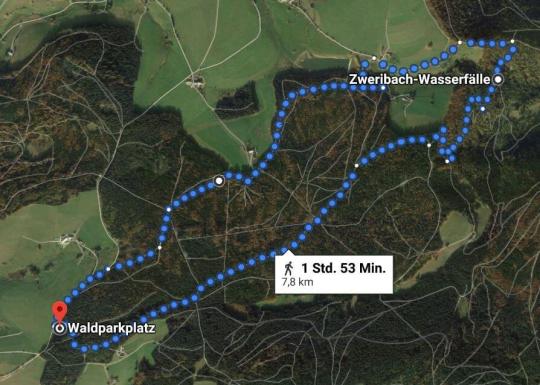
Start vom Waldparkplatz, Pause am Stausee, weiter zu den Wasserfällen Am Waldparkplatz St. Peter angekommen, sind wir direkt den nächstliegenden Waldweg wieder eingebogen und auf breitem Waldweg entlang Richtung Stausee gelaufen. Dieser ist gut in 30-45 Minuten zu erreichen, mit Kindern, ohne ginge es sicherlich schneller. Dort lässt sich gut eine kleine Vesper Pause einrichten, was wir dann auch gemacht haben. Nach dieser kurzen Pause ging es dann weiter den Wasserfällen entgegen. Ein kleines letztes Waldstück, dann entlang wundervoller Blumenwiesen mit Ausblick ins Tal. Wundervoll! Die Zweribachwasserfälle liegen mitten im Bannwald Das letzte Stück zu den Wasserfällen führt direkt durch den Bannwald. Der Weg ähnelt hier eher einem gut "ausgebauten" Trampelpfad, ist aber gut zu laufen, noch. Von der Unberührtheit des Bannwaldes begeistert ist man bei dem Abstieg dann doch relativ schnell bei den Zweribachwasserfällen. Jedenfalls im oberen Bereich dieser. Es führt eine kleine Brücke zwischen dem mittleren und oberen Bereich des Wasserfalls. Auf Bildern lässt sich die Atmosphäre einfach auch nicht einfangen. Aber seid versichert, es ist wunderschön.
Zurück zum Auto beim Waldparkplatz
Um nicht den gleichen Weg wieder zurückzulaufen, meine Frau mag selten Wege doppelt gehen sondern bevorzugt Rundwege, sind wir den Trampelpfad schnurstracks weiter gelaufen. Der Weg war ab dem Wasserfall nicht immer auf den ersten Blick zu finden, bzw wurde von nicht gerade kleinen, umgefallenen Bäumen versperrt. Für die Kinder ein wahrer Abenteuer weg. Zwischenzeitlich ist der Weg auch direkt neben starkem Gefälle, was für unsere Große teilweise ein wenig zu viel Adrenalin bedeutet hat. Tatsächlich war dieser kleine Teil ihr sogar etwas unheimlich. Bis man wieder auf gut begehbarem Waldweg ist, dauert es ein wenig. Die ganze Strecke die man runter gelaufen ist, muss man ja auch wieder hoch. Ich fand dies nicht problematisch und freue mich auch schon auf unseren nächsten Besuch im Bannwald bei den Zweribachwasserfällen.
Eindrücke von der Wanderung zu den Zweribachwasserfällen
#jtg-38 .item .jtg-social a { color: #ffffff }#jtg-38 .item .caption { background-color: #ffffff; }#jtg-38 .item .figc {color:#ffffff;}#jtg-38 .item .figc .jtg-title { font-size: 16px; }#jtg-38 .item { transform: scale(1); }#jtg-38 { width:100%;}#jtg-38 .items{height:800px;}#jtg-38 .items .figc p.description { color:#ffffff;font-size:14px; }#jtg-38 .items .figc .jtg-title { color:#ffffff; }


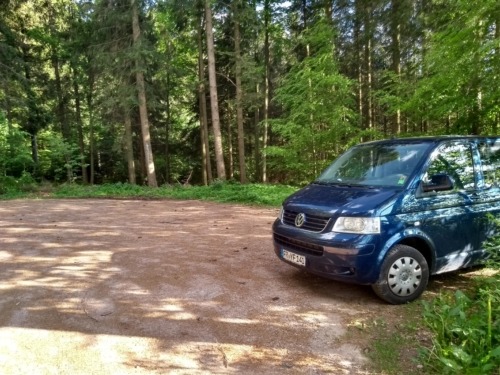
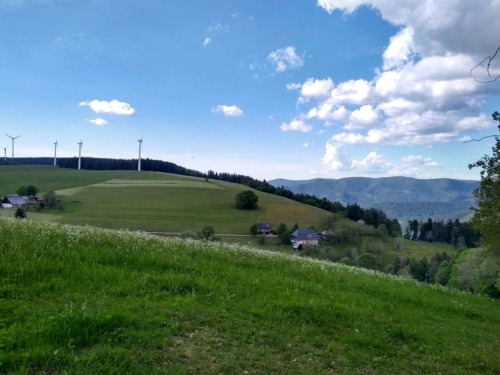

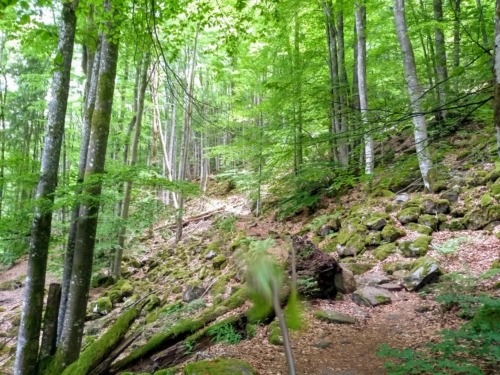



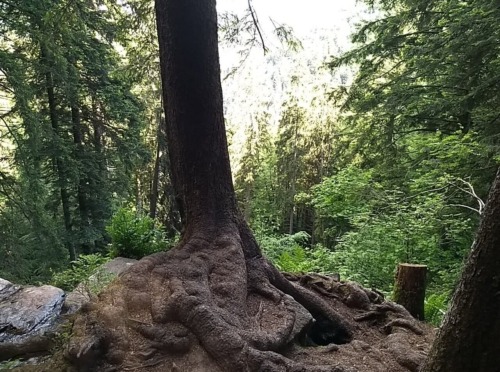
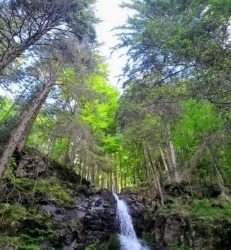
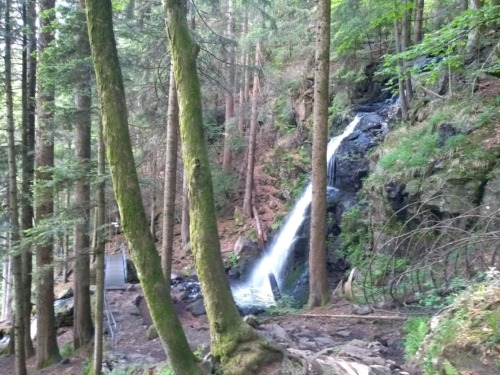
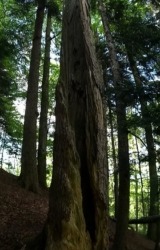
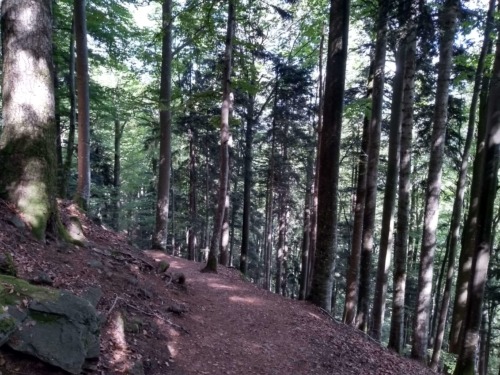

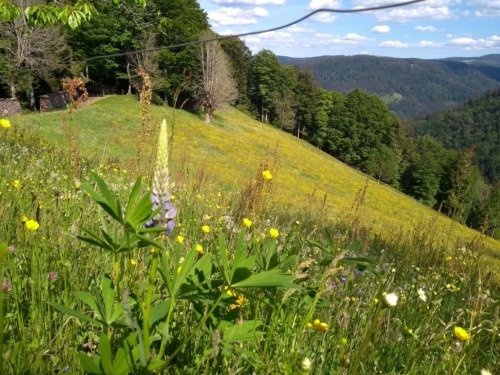



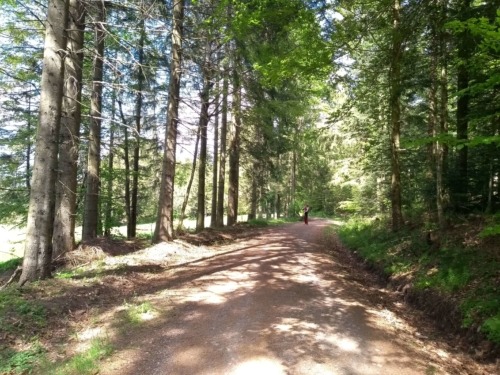
Weitere Informationen im Netz
Zweribachwasserfälle auf Wikipedia Bannwald auf Wikipedia Alternativ Route bei hochschwarzwald.de Read the full article
#Ausflug#Bannwald#Colmar#Familienausflug#Glottertal#Herdern#Schauinsland#St.Peter#TodtnauerWasserfälle#TribergerWasserfälle#Waldparkplatz#Wanderung#Wasserfall#Zweribachwasserfälle
2 notes
·
View notes
Text
Glotterwerk: die verspätete wertbeständige Anleihe von 1924
Ende 1923 brach in der Hyperinflation die deutsche Markwährung endgültig zusammen. Viele Unternehmen mussten für ihre Investitionen nach kreativen Lösungen zur Schaffung von wertbeständigem Anleihekapital suchen. Eine von vielen seinerzeitigen Finanzkonstruktionen waren auf US-Dollar bzw. Feingold abgesicherte, wertbeständige Anleihen. Die badische Glotterwerk AG begab hierzu im Februar 1924 in Mark deutscher Reichswährung ausgestellte 6%ige Teilschuldverschreibungen, abgesichert auf den amerikanischen Dollar. Obwohl die Währungssanierung der Mark Anfang 1924 bereits vollzogen war, kam die Anleihe dennoch auf den Markt, wahrscheinlich um amerikanische Spekulanten zu bedienen.
Um eine bessere Stromversorgung im Glottertal zu erreichen, wurde am 23. Januar 1923 die im badischen Freiburg ansässige „Glotterwerk Aktiengesellschaft“ gegründet und kurze Zeit später in „Glotterwerk AG Süddeutsche Electricitäts-Gesellschaft“ umbenannt. Die Gesellschaft sollte durch Ausnutzung der Wasserkraft der Glotter die Elektrifizierung des Glottertals voranbringen. Die Glotter (auch: Glotterbach) ist ein etwa 40 Kilometer langer Zufluss des Flusses Dreisam im Schwarzwald in Baden-Württemberg.
Das Glotterwerk hatte Großes vor. Es wollte in den tiefen Tälern des Kandelmassivs mehrere Talsperren errichten und ein großes Kraftwerk bauen. Das Projekt hatte die volle Unterstützung der damaligen Landesregierung und die Planung war weit fortgeschritten, als die Hyperinflation und die Wirtschaftskrise des Jahres 1923 die Finanzierung des Projekts erheblich behinderten.

Glotterwerk AG, Teilschuldverschreibung über 10 Milliarden Mark, Serie 1A, Nummer 2, ausgestellt in Freiburg im Februar 1924
Zwar war Anfang 1924 im Deutschen Reich nach Einführung der Rentenmark (der späteren Reichsmark) die deutsche Hyperinflation bereits Geschichte, dennoch begab im Februar 1924 die Glotterwerk AG unverdrossen 6%ige, auf US-Dollar und Feingold abgesicherte, wertbeständige Teilschuldverschreibungen mit 10 Milliarden Mark Reichswährung Nennwert und einem Volumen von 250.000 US-Dollar, entsprechend 375 Kilogramm Feingold.
Aufgedruckt auf jeder Teilschuldverschreibung zeigen sich folgende interessante Anleihekonditionen, nachfolgend wörtlich wiedergegeben:
Teilschuldverschreibung über 10 Milliarden Mark Reichswährung rückzahlbar mindestens mit 75 Cents USA-Währung. Die Glotterwerk Aktiengesellschaft Süddeutsche E1ektricitäts-Gesellschaft in Freiburg in Baden (Deutschland) hat zum Zwecke des Ausbaues der Wasserkraft der Glotter die Aufnahme von Anleihen bis zum Betrage von 375 kg Feingold, entsprechend $ 250.000 beschlossen, eingeteilt in 10 Serien von je 37,5 kg Feingold = $ 25.000.
Die Glotterwerk Aktiengesellschaft Süddeutsche Elektricitäts-Gesellschaft, vertreten durch den unterzeichneten Vorstand, verpflichtet sich, durch vorliegende, einen Teil der Anleihe bildenden Teilschuldverschreibung der Firma G. von Polenz in New York oder deren Order 10 Milliarden Mark Reichswährung gemäß nachfolgenden Bedingungen zu bezahlen.
Die Schuld ist seitens des Gläubigers unkündbar, vom 1. Januar 1924 an mit jährlich 6% in halbjährlichen Raten verzinslich und nach erfolgter Kündigung, spätestens jedoch am 2. Januar 1954 zum Nennbetrage oder zum gesetzlichen Umrechnungskurse in einer etwaigen neuen Deutschen Reichswährung rückzahlbar, aber mit mindestens 75 Cents USA-Währung.
Die Anleihe ist seitens der Schuldnerin unkündbar bis zum 31. December 1933. Von diesem Zeitpunkt an hat die Gesellschaft das Recht, die gesamte Anleihe oder eine oder mehrere Serien unter Einhaltung einer sechsmonatigen Frist zur Rückzahlung zu kündigen.
Die Serien und Nummern der gekündigten Schuldverschreibungen und der Termin der Rückzahlung werden im „Deutschen Reichsanzeiger“ bekannt gemacht.
Der vorliegenden Teilschuldverschreibung sind 20 halbjährliche Zinsscheine, lautend über je 0,3 Milliarden Reichsmark und fällig am 1. Juli und 2. Januar jeden Jahres, erstmalig am 1. Juli 1924, sowie ein Erneuerungsschein beigegeben. Die Einlösung der Zinsscheine erfolgt mit dem Eintritt der Fälligkeit in Reichsmark oder zum gesetzlichen Umrechnungskurs in einer etwaigen neuen Deutschen Reichswährung.
Zahlungen erfolgen jeweils bei der Kasse der Gesellschaft in Freiburg; die Gesellschaft behält sich vor weitere Zahlstellen bekanntzumachen. Die Zahlung des Kapitals erfolgt nur gegen Rückgabe der Teilschuldverschreibung nebst den dazugehörigen, noch nicht fälligen Zinsscheinen und dem Erneuerungsschein. Fehlende Zinsabschnitte werden nach ihrem Nennwert an der Kapitalssumme in Abzug gebracht. Die Verzinsung endet mit dem Tage, an dem die Rückzahlung fällig wird.
Der Kapitalbetrag der gekündigten Teilschuldverschreibungen verfällt zugunsten der Gesellschaft, wenn die Einlösung nicht binnen 30 Jahren nach dem Fälligkeitstermin gefordert wird.
Die Zinsscheine verjähren mit dem Ablauf des zehnten Kalenderjahres seit ihrer Fälligkeit. Für das Aufgebotsverfahren im Falle der Vernichtung oder des Abhandenkommens der Schuldverschreibung und für die Geltendmachung von Ansprüchen bei verlorengegangenen Zinsscheinen gilt die jeweilige deutsche Gesetzgebung.
Zur Sicherheit der vorstehend eingegangenen Verpflichtungen hat die Gesellschaft auf ihrem Grundbesitz in Waldkirch bei Freiburg eine Sicherungshypothek eintragen lassen und das Bankhaus G. von Polenz zum Vertreter der jeweiligen Gläubiger bestellt. Freiburg im Februar 1924. Glotterwerk Aktiengesellschaft Süddeutsche Electricitäts-Gesellschaft

Glotterwerk AG, Teilschuldverschreibung über 10 Milliarden Mark, Serie 1A, Nummer 2, ausgestellt in Freiburg im Februar 1924 – Rückseite in englischer Sprache
Die Anleihezertifikate sind vorderseitig in deutscher Sprache verfasst, rückseitig gibt es eine Übersetzung in die englische Sprache. Der Grund hierfür: Das New Yorker Bankhaus G. von Polenz übernahm einen Teil der Anleihe zur Platzierung in den Vereinigten Staaten.
Deutsches Reich - die Situation im Dezember 1923: Durch die Hyperinflation war die Mark in der Währungsreform 1923/24 auf „1 Goldmark = 4,20 US-Dollar = 1 Billion Mark Reichswährung (= Papiermark)“ herabgewertet worden. Der Wert einer dieser Teilschuldverschreibungen über 10 Milliarden Mark Reichswährung war demnach auf ein Prozent von Goldmark und US-Dollar herabgesunken (= 0,01 Goldmark bzw. 0,042 US-Dollar). Allerdings waren ja glücklicherweise nach den Anleihebedingungen 0,75 US-Dollar je 10 Milliarden Mark Nennwert abgesichert und garantiert.
Ein Teil die Teilschuldverschreibungen wurde am 21. Mai 1924 in New York durch Aufstempeln in „Profit Sharing Certificates“ umgewandelt und auf den Bankier G. von Polenz übertragen. Vermutlich wurden diese Teilschuldverschreibungen tatsächlich in den Vereinigten Staaten platziert, aber danach nie oder nur mit wenig Geld bedient. Zumindest laufen 96 Jahre nach ihrer Ausgabe immer noch einige wenige Stücke in Deutschland und erstaunlicherweise auch in den Vereinigten Staaten von Amerika umher.
Der Umlauf der Teilschuldverschreibungen in den Vereinigten Staaten hängt mit den Aktivitäten des New Yorker Bankiers von Polenz zusammen, denn amerikanische Spekulanten erwarben in der Zeit der deutschen Hyperinflation (bis Ende 1923) gern deutsche Staatsanleihen, Industrieschuldverschreibungen, Aktien, etc., sozusagen zu „Cent- bzw. Pfennigpreisen“, in der Hoffnung auf eine später für „Sie“ profitable Währungssanierung in Deutschland.
Die Aufwendungen in Dollar für solche Spekulationswertpapiere waren seinerzeit für Devisenbesitzer nur geringfügig. So hätte ein Amerikaner im Dezember 1923 bei einem Wechselkurs von „1 Goldmark = 4,20 US-Dollar = 1 Billion Mark“ für 4,20 US-Dollar theoretisch 10.000 Stücke deutsche Anleihezertifikate über nominal je 100.000 Mark erwerben können (bzw. 100 Stücke deutsche Anleihezertifikate über nominal je 10 Milliarden Mark).
Bei diesen spekulativen Anleihen wurde die Währungsspekulation aufgrund der sich rasant entwickelnden Hyperinflation und der ungünstigen Umtauschrelation zur neugeschaffenen Rentenmark bei der Währungsstabilisierung 1923/24 jedoch ad absurdum geführt.
Solche damals erworbene, spekulative Wertpapiere befinden sich teilweise heute noch in den Händen der Nachkommen früherer amerikanischer Spekulanten. Ein weiterer Grund für die vielen heute noch im Ausland auftauchenden, deutschen Inflationsanleihen: Im Dritten Reich erfolgte eine große Auswanderungswelle in die Vereinigten Staaten und andere Staaten, insbesondere durch vermögende, jüdische Bürger des Deutschen Reiches. Viele nahmen ihre unbedienten Anleihestücke in der Hoffnung auf eine spätere Entschädigung mit in die Emigration. Solche Papiere finden sich manchmal auch heute noch in den Nachlässen der Nachkommen solcher Emigranten.
Inflation, Weltwirtschaftskrise und die oben beschriebene missglückte Finanzierung beendeten das Elektrifizierungsprojekt der Glotterwerk AG jäh. Mit den wenigen eingesetzten finanziellen Mitteln erreichte die projektierte Anlage am Kandel nur die geringe Energieleistung von 1.368 Kilowatt. Die unbedeutende Stromversorgung der Glotterwerke endete allerdings erst 1951, da wurde die Gesellschaft aufgelöst.

Blick ins Glottertal
Bildquellen: HGG und Wikipedia (9/2020)
-
Hans-Georg Glasemann
Ich bin für Sammler Historischer Wertpapiere aktiv im EDHAC. Unterstützen Sie uns, werden Sie Mitglied … Wenn Sie diesen Blog kostenlos abonnieren wollen, klicken Sie oben rechts „RSS-Feed“. Ältere Beiträge des Blogs finden Sie, wenn Sie „Archiv“ klicken! Besuchen Sie den EDHAC bei … Facebook!
1 note
·
View note
Photo

Thomashütte (Kandel, Glottertal)
2 notes
·
View notes
Text
Friday, 27th September 2019 – Waldkirch-Buchholz, Schonach, Triberg, Vaals
Most of the day was spent in the car on a variety of German autobahns, peering into clouds of spray and trying not to crash but before that we managed both a small amount of shopping and some sightseeing. First though, one more very good breakfast at the Hotel Schlossmühle, before a comprehensive repack of the car boot to make sure everything was secure and wouldn’t rattle too much, and that the grape vine I’d bought at Naturoparc, a Gewürztraminer, wasn’t going to get crushed or otherwise damaged.

After I’d done that I took a short walk into town and stopped off at the butcher’s to buy half a kilo of Black Forest ham, and a large pack of maultaschen that would go into the freezer when we got home. The lovely man behind the counter also handed me a present of couple of large slices of paté-en-croute which would do for our lunch for the first two days after we got home. From there we drove over to Waldkirch-Buchholz to Weingut Moosman to buy a couple of cases of the wines we had drunk the day before at the Alte Wache in Freiburg. And again I was given a present, a jar of local fruit jelly. I was going to struggle when shopping on my return home, because I’d be wondering why no one was giving me a gift along with my shopping.

I then spent a few minutes having a fight with the SatNav. Before we set off I had worked out how to add a driving route to its memory and was able to call that up and set it to navigate us along the way. What it didn’t seem able to handle was taking me to the nearest point on the route, rather than the absolute starting point, and as a result we ended up navigating round the centre of Freiburg more than once in several different directions before I gave up and entered a way point and told it to take us there! I had wanted to cover some of the Black Forest Road but we wasted so much time on trying to achieve escape velocity from Freiburg that we ran out of time. Instead we decided to head for Triberg and Germany’s highest waterfall.

On the way we were sidetracked, as we so often are, by Schonach, which is a pretty odd little place all told. It has around 4,000 inhabitants and is known for winter sports, with a number of famous athletes coming from the town, which explains why one of its advertised attractions is the Langenbach ski Jumping hill, which you can visit every Wednesday between 14:00 and 16:00 and climb up to the jumping point. It doesn’t explain the giant living advent calendar which of course we didn’t see, it being the wrong time of year. The Church of Saint Urban seems standard enough, but then there are two cuckoo clocks, and these are not just any cuckoo clocks. One is the world’s biggest cuckoo clock, and believe me it is big, and then there’s the first world’s biggest cuckoo clock.

This was built by Jürgen Dold and is 3.60 metres wide, 3.10 metres high, and 1 metre deep, and is housed in a small Black Forest style house. It’s open daily from 09:00 – 12:00, though we arrived just after 12:00 and were still invited in. It cuckoos on the hour and the half hour so we settled in on a bench in the garden to wait.

After that we headed into Triberg and parked up. Triberg as a name is first mentioned in any document in 1239 when Peter of Triberc is listed as a witness to a transaction, and in 1330 there is the first mention of an actual place called Triberg which seems to have had a castle as well. The Hohenbergs, who had held the castle for four generations, died our and the property passed in the hands of Duke Albrecht of Austria. It remained an imperial fief of the Habsburgs for around four centuries, and seems to have been a pretty miserable time for the townspeople. In 1654 they finally reached breaking point after years of suppression, poverty and being sold off to the highest bidders, and they raised 30,000 guilders to buy their independence. As a result Archduke Ferdinand Karl of Austria issued an edict that confirmed that the privileges of Triberg could never be pledged or sold.

By 1720 the town consisted of 422 inhabitants, living in 35 houses. By 1800 the population had pretty much doubled to 792. Shortly afterwards, the locals began to try and develop the waterfalls as a tourist attraction, setting up pathways to let the visitors get closer. A year later, after the Peace of Pressburg, 16 German princes joined forces under Napoleon’s military and political protection to form the Rhine Confederation, and Triberg became part of the new Grand Duchy of Baden. After Grand Duchess Stephanie visited the waterfalls in 1815 more and more visitors arrived and Triberg was established as a tourist attraction. A serious fire in 1826 burned down most of the town which is why it’s not packed with half-timbered buildings. The rebuilding was of course done in what was a contemporary style at the time. In 1864 further steps were taken to turn the town into a Spa, with the a beautification committee being set up. They were assitsed in their efforts when the Black Forest Railway opened a decade later. Modernisation continued apace and Triberg was the first city in Germany to erect publicly owned electric street lights.They were keen on the new in Triberg, and also set up the world’s first electric ski lift in the early 1900s, kicking off the area’s development as a winter sports centre.

We didn’t have a lot of time, but we wanted to take a quick look at the waterfall, especially as they would likely be at their best after a couple of days of heavy overnight rain. First though we found ourselves face to face with the second set of Easter island-inspired sculptures of the trip, after the strange ones in the Parc Malraux in Illkirch-Graffenstaden. These five sculptures on the waterfall path are the work of German-Brazilian multi-artist Woody Woodnock, also known as Michael Nock. They started life as the largest Douglas firs that could be found in the city forest, and weigh around 1.8 tonnes each, with a circumference of up to 2.70 metres. They were named Edekaner after a naming competition and they are just subtly insane, wearing, as they do, Bollenhuts, the women’s hats with red pompoms on the top that were worn by unmarried women from just three villages in the Black Forest but which are now regarded as representative of the whole area.

We crossed the road to the waterfall, thinking that the town looked attractive, for another time. The waterfall drops 163 meters down via a series of cascades and pools, as the River Gutach finds its way down to the valley floor. As with may German towns that have some sort of dramatic water feature, the locals will try and convince you that the water is good for your health, and that because it ionises the air, it is beneficial if you have bronchial asthma or a cold. That aside, they really are most impressive, and can be viewed at all times of year, including at Christmas when they are part of the Triberger Weihnachtszauber. They’re also lit up at night, so it would be hard to miss them!

The paths are steep, and slippery and the “easy” path was closed off so it was a case of slipping and sliding my way up about halfway, looking out for the friendly squirrels that are now so used to visitors that they just hang about begging for food. Maybe it was too damp, but I only saw one, and it wasn’t hanging about for a photoshoot, perhaps because I didn’t have anything to give in return.

We ran out of time so I scrambled back down again (which was a lot harder than going up had been) and we headed to the car to set off for the Belgian/Dutch/German border which was rather further away than I really liked the look of but would make Saturday a very easy day in comparison to today. We were staying just inside the Netherlands in a small town called Vaals, where I had managed to find a very nice looking place to lodge for a night. It was also just a short drive from the centre of Aachen so we could have a day there before we headed for the overnight ferry. Vaals is in the extreme southeastern part of the Dutch province of Limburg, in the southeastern part of the Netherlands and borders on both Belgium and Germany. The three borders meet at the Drielandenpunt, close to the highest point in the Netherlands, the Vaalserberg. Around a quarter of the population is actually German, and many of them work in the nearby German city of Aachen. Tourism is now a major source of income, though its fortunes were founded on coal and textiles during the industrial age. It seems to have been occupied by the Romans, and is one of a handful of places in the Netherlands with a name that comes from the Latin. Certainly the Limburg area was densely populated during Roman times, with a focus on Cologne (Colonia Claudia Ara Agrippinensium).

Vaals is first mentioned in documents in 1041 when Emperor Henry III donated land to the Abbey of Saint Adalbert and made a distinction between the city of Aachen and this land by referring to it as “in Vallis” (in the valley). Given its geographical position it saw a lot of action during the various wars, including the time, in 1568, when the forces of William of Orange looted the church. In 1661 Vaals joined the Republic of the United Netherlands and as many wealthy citizens moved in, it became a prosperous industrial hub with numerous famous visitors. The Conference of Vienna assigned Aachen to Prussia and Vaals to the Kingdom of the Netherlands though when Belgium declared independence in 1830, Vaals became part of Belgium for 9 years. Afterwards it returned to the Kingdom of the Netherlands, sitting on four national boundaries (Prussia, Belgium, the Netherlands and the Neutral Territory of Moresnet). As a result of the less than nation-state of Moresnet, there was a Four-Border-Point, but not a Four-Country-Point although the Viergrenzenweg (“Four-Borders-Road”) still exists in Vaals. After 1919 Moresnet was absorbed into Belgium.

After 1840, when the various borders were closed, Vaals turned from a wealthy industrial town into a leisure and holiday destination complete with casinos. The Germans referred to the town as the “Vaalser Paradies” and a tram was built running to and from Aachen, via Vaals. During World War II the town was very isolated and post-war many of the townsfolk found jobs in Aachen legally while illegally smugglers’ routes across the border abounded as the “Owls of Vaals” plied their trade. Nowadays the town can best be regarded as Dutch suburb of a German city and it is even well integrated into Aachen’s transport system with rerular cross border buses.

We were staying at the rather swish Hotel Kasteel Bloemendal, built in the late 1700s for the Aachen cloth manufacturer Arnold von Clermont. A very rich man, with clients that included the Tzar, set about building a palace opposite his new weaving mill. In fact both Peter the Great and Napoleon Bonaparte have stayed in the castle, the latter much later on of course. Arnold died before the work was complete, and it was left to his son to carry on both the business and the building work. After the recession caused by the French Revolution the house was sold to the Aachen City Councillor Johann Wilhelm van Lommessen, who donated the building to the order of the Sacred Heart, a women’s religious order that his two daughters, Anna and Caroline, joined.

It became a renowned Catholic boarding school, both in Europe and beyond, with pupils that included Rose Kennedy. During the occupation of 1940-1944 it became hospital with 350 beds, but reverted to being a boarding school after 1947, continuing until the 1970s when the number of both pupils and nuns started to decline. In 1976, almost 130 years of monastic life came to an end and by 1978 the building was owned by the municipality of Vaals. After slightly more than a decade, the municipality, along with van der Valk hotels, in collaboration with the province of Limburg and the Netherlands Conservation Agency, decided to restore the complex and reopen it as a luxury hotel. It really is glorious and it would have been a shame if it had been left to decay! After a series of irritating delays on the motorways, and a number of detours to avoid it, we were later arriving that we had planned to be, so they moved our dinner booking back, giving us time to clean up. They also gave us an upgrade to one of the castle rooms, free of charge so we were very happy (and very comfortable).
Travel 2019 – Alsace and Baden, Day 15, Waldkirch-Buchholz, Schonach, Triberg, Vaals Friday, 27th September 2019 - Waldkirch-Buchholz, Schonach, Triberg, Vaals Most of the day was spent in the car on a variety of German autobahns, peering into clouds of spray and trying not to crash but before that we managed both a small amount of shopping and some sightseeing.
#2019#Alsace and Baden#Arts#Baden#Europe#Food and Drink#Germany#Glottertal#Hospitality#Hotel Kasteel Bloemendal#Hotels#Museums#Netherlands#Schonach#Travel#Triberg#Vaals#Waldkirch-Buchholz#Weingut Moosmann#Wine
0 notes
Photo

09-26 'Christian Kohlund, Ehefrau Elke Best, ''Schwarzwald''-Mädchen, Wolfgang Rademann (Produzent), Party am Rande der Dreharbeiten zur ZDF-Serie ''Schwarzwaldklinik'' am 31.08. ... http://dlvr.it/PqZhCC
1 note
·
View note
Photo

Zu Besuch in Glottertal 😊 #glottertal #freiburg #stblasius #bobbelejens #followme #freiburgerbobbele #unterwegs #urlaub #sommer #sonne #church #kirche #art #gemälde #freizeit (hier: Unterglottertal) https://www.instagram.com/p/BygC4f4iYPS/?igshid=1bcqyx1yrq2wz
#glottertal#freiburg#stblasius#bobbelejens#followme#freiburgerbobbele#unterwegs#urlaub#sommer#sonne#church#kirche#art#gemälde#freizeit
0 notes
Photo

1 note
·
View note
Photo

Die Schwarzwaldklinik ... by HJB_2403
2 notes
·
View notes
Text







Glottertal Schwarzwald Distilery. Now I've learned how to Distil liquer.
2 notes
·
View notes
Video
DSC04039.jpg von Rainer Über Flickr: Im Glottertal
0 notes
Photo






Series “Knights of the Present”, Photography, 2016
1. Traditional costume at Corpus Christi in the Glottertal/Black Forest.
2. A girl at her first communion in St. Peter in the Black Forest. From the series “Bridal Crowns”, 2011 © Iwajla Klinke
3+4. A Sorbian “Vogelhochzeit” (Bird Wedding), 2010 Iwajla Klinke
5. “Bridal Crown”,2010 © Iwajla Klinke
6. “Kermis in Santanna, Rumania”(Church consecration),2010 © Iwajla Klinke
20 notes
·
View notes
Photo

Das sind diese #Wolken, die mich dann später nass gemacht haben. #MTB #mountainbike #cycling #radfahren #fahrradfahren #biking #radtour #schwarzwald #Kandel #thomashütte #glottertal (hier: Kandel) https://www.instagram.com/p/BnZiYQMlB--/?utm_source=ig_tumblr_share&igshid=1d15tqsg6d5e1
#wolken#mtb#mountainbike#cycling#radfahren#fahrradfahren#biking#radtour#schwarzwald#kandel#thomashütte#glottertal
0 notes
Photo

Meet & Greet at 7:30 in #glottertal #blackforrest to ride the classic Oetztaler prep ride with a lot of climbing. > 4k m in the end. ⛰⛰⛰⛰⛰⛰ Perfect weather conditions with ☀️ but not too hot. Marbod, Marion, tour initiator Rainer, speedy Ralf, Olli & Markus from Hockenheim pirates and later we met Jürgen. 😎 https://www.strava.com/activities/1765503383 #cycling #roadcycling #goprocycling #strava #stravacycling #stravaproveit #stravadventure #stravaphoto #indianastones4ever #simplonpavo #simplon #simplonbike #bergstrasse #weinheim #odenwald #teambergstrasse #rscalpenespresso #acweinheim (hier: Gemeindeverwaltung Glottertal)
#glottertal#blackforrest#cycling#roadcycling#goprocycling#strava#stravacycling#stravaproveit#stravadventure#stravaphoto#indianastones4ever#simplonpavo#simplon#simplonbike#bergstrasse#weinheim#odenwald#teambergstrasse#rscalpenespresso#acweinheim
0 notes
